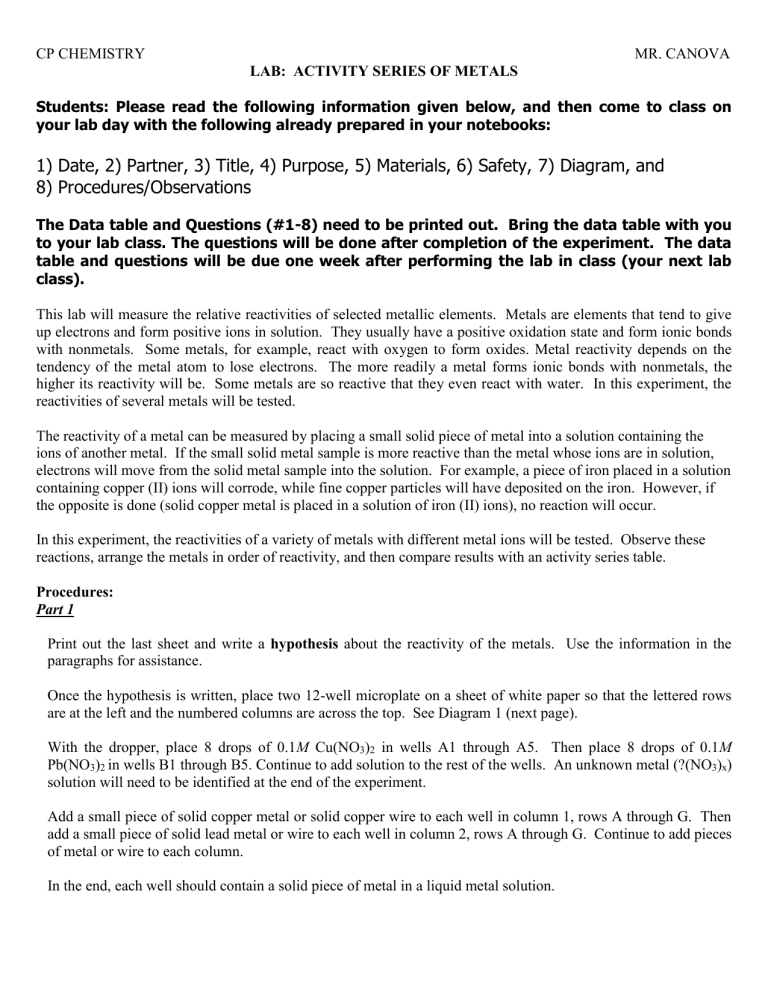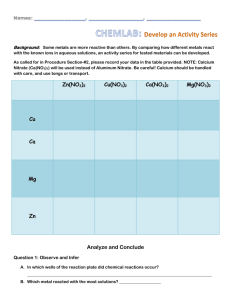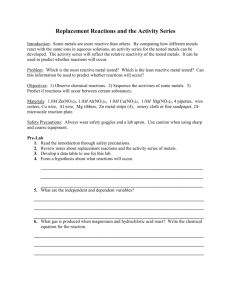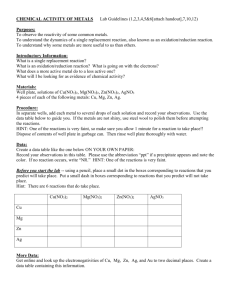CP CHEMISTRY

CP CHEMISTRY MR. CANOVA
LAB: ACTIVITY SERIES OF METALS
Students: Please read the following information given below, and then come to class on your lab day with the following already prepared in your notebooks:
1) Date, 2) Partner, 3) Title, 4) Purpose, 5) Materials, 6) Safety, 7) Diagram, and
8) Procedures/Observations
The Data table and Questions (#1-8) need to be printed out. Bring the data table with you to your lab class. The questions will be done after completion of the experiment. The data table and questions will be due one week after performing the lab in class (your next lab class).
This lab will measure the relative reactivities of selected metallic elements. Metals are elements that tend to give up electrons and form positive ions in solution. They usually have a positive oxidation state and form ionic bonds with nonmetals. Some metals, for example, react with oxygen to form oxides. Metal reactivity depends on the tendency of the metal atom to lose electrons. The more readily a metal forms ionic bonds with nonmetals, the higher its reactivity will be. Some metals are so reactive that they even react with water. In this experiment, the reactivities of several metals will be tested.
The reactivity of a metal can be measured by placing a small solid piece of metal into a solution containing the ions of another metal. If the small solid metal sample is more reactive than the metal whose ions are in solution, electrons will move from the solid metal sample into the solution. For example, a piece of iron placed in a solution containing copper (II) ions will corrode, while fine copper particles will have deposited on the iron. However, if the opposite is done (solid copper metal is placed in a solution of iron (II) ions), no reaction will occur.
In this experiment, the reactivities of a variety of metals with different metal ions will be tested. Observe these reactions, arrange the metals in order of reactivity, and then compare results with an activity series table.
Procedures:
Part 1
Print out the last sheet and write a hypothesis about the reactivity of the metals. Use the information in the paragraphs for assistance.
Once the hypothesis is written, place two 12-well microplate on a sheet of white paper so that the lettered rows are at the left and the numbered columns are across the top. See Diagram 1 (next page).
With the dropper, place 8 drops of 0.1
M Cu(NO
3
)
2
in wells A1 through A5. Then place 8 drops of 0.1
M
Pb(NO
3
)
2 in wells B1 through B5. Continue to add solution to the rest of the wells. An unknown metal (?(NO
3
) x
) solution will need to be identified at the end of the experiment.
Add a small piece of solid copper metal or solid copper wire to each well in column 1, rows A through G. Then add a small piece of solid lead metal or wire to each well in column 2, rows A through G. Continue to add pieces of metal or wire to each column.
In the end, each well should contain a solid piece of metal in a liquid metal solution.
CP CHEMISTRY MR. CANOVA
LAB: ACTIVITY SERIES OF METALS
Diagram 1
A Cu(NO
3
)
2
B Pb(NO
3
)
2
C Fe(NO
3
)
3
D Mg(NO
3
)
2
E Zn(NO
3
)
2
F AgNO
3
G ?(NO
3
) x
1 2 3 4 5
Cu Pb Fe Mg Zn
O O O O O O
O O O O O O
O O O O O O
O O O O O O
O O O O O O
O O O O O O
O O O O O O
Part 2
After 5 minutes, some of the metals are active enough to have reacted and replaced the metal ions of the solution.
Observe any change in the metals or the solutions and record the changes on the Microplate Data Form that was printed out.
In the lower right hand corner of each box add a ( + ) to show that a reaction occurred and a ( 0 ) to indicate that no reaction occurred. Recall that formation of a precipitate or a gas or a change in the color of the solution may indicate that a reaction took place. Describe what is seen if a reaction occurs. See Diagram 2 below:
1 2
X X
Diagram 2
X(NO
3
)
2
Bubbles formed
+ 0
Finally, use small tongs or scoopulas to remove the metals from each well and place on a piece of paper.
Throw out in the garbage.
Then thoroughly rinse the well plate and use a scrub brush to clean it out.
CP CHEMISTRY MR. CANOVA
Name______________________________________
Period_________________
Date_____________
Lab Group #_______
LAB: ACTIVITY SERIES OF METALS
Data: print this out! You will use this sheet in lab, so you must have it with you on your lab day.
Hypothesis:
Microplate Data Form:
A Cu(NO
3
)
2
B Pb(NO
3
)
2
C Fe(NO
3
)
3
D Mg(NO
3
)
2
E Zn(NO
3
)
2
F AgNO
3
G
?(NO
3
) x unknown
1
Cu x
2
Pb x
3
Fe x
4
Mg x
5
Zn x
CP CHEMISTRY MR. CANOVA
Name______________________________________
Period_________________
Date_____________
Lab Group #_______
LAB: ACTIVITY SERIES OF METALS
Rewrite hypothesis below:
Hypothesis:
Analysis:
1.
Did all the solid metals react in the same way? Explain your answer in complete sentences:
2.
Were there any solid metals that did not react at all? If so, which ones? Explain your answer in complete sentences:
3.
Determine the number of reactions of each solid metal listed below. Record in the table:
Solid Metal Cu Pb Fe Mg Zn
# of reactions
Conclusions:
1. Arrange the solid metals in order of reactivity, from the highest to the lowest.
2. Which solid metal is the most active? ____________ 3. Which solid metal is least active? _____________
4. Did your results support your hypothesis about the reactivity of the metals? Explain in thorough sentences.
5. How do your results compare with a table of metal reactivities in a reference book or provided by your
teacher?
Unknown: (to be used for performance assessment grade)
Identify your unknown sample number __________________
Identify the unknown that you received during this laboratory exercise ____________________







